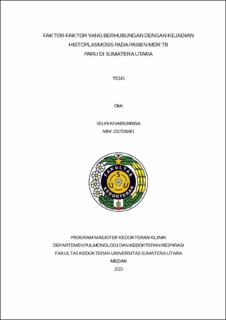| dc.description.abstract | Background and Aims: Histoplasmosis is an infectious disease caused by the dimorphic fungus Histoplasma capsulatum, which, in chronic conditions, is generally difficult to distinguish from pulmonary tuberculosis based on its clinical appearance therefore, diagnostic errors can occur. Meanwhile, the prevalence of Multidrug-Resistant Pulmonary Tuberculosis (MDR PTB) in Indonesia remains high. The purpose of this research was to analyze the correlation between risk factors and histoplasmosis incidence in MDR PTB patients at H. Adam Malik General Hospital, North Sumatera. Currently, no study has determined the incidence of histoplasmosis in MDR PTB worldwide.
Methods: This research is an analytic study with a cross-sectional design for fifty patients with MDR PTB. The ELISA platform (semi-quantitative) was used to detect histoplasma antibodies, and the determinant factors were analyzed by multivariate analysis. Multiple logistic regression analysis is used, with a significance level of 5% (α = 0.05) and a confidence interval value of 95%.
Results: The result from the early stage of logistic regression analysis with a 28% prevalence of histoplasmosis found the dominant variable related to histoplasmosis in MDR PTB patients, namely positive AFB results and age group 31–45 years old, where both increased the risk by 6.1 times and 3.4 times, respectively, with the incidence of histoplasmosis. In the final stage of multivariate analysis, it was found that chest radiological grading with far-advanced lesions increased the risk of histoplasmosis by a p value of 0.017, OR = 0.048 (95% CI = 0.004-0.577), and this relationship was statistically significant (p<0.05). Conclusion: In conclusion, the occurrence of histoplasmosis was detected based on the antibody Histoplasma. The chest radiological grade with a far-advanced lesion among MDR-PTB patients is one of the risk factors for histoplasmosis. | en_US |




